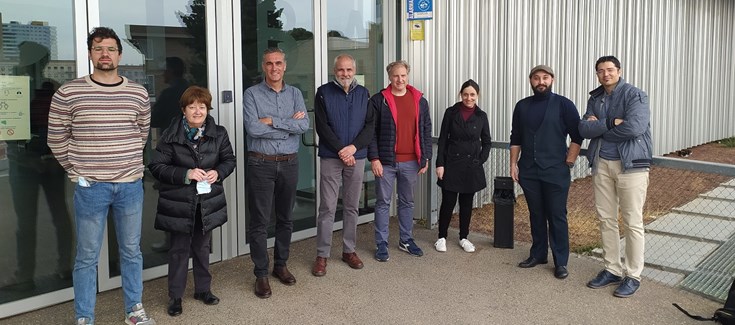Using genetic editing, they are studying the response to a protein that may play a key role in storing squalene in the liver.

From left to right: Javier Sanchez-Marco, Jesus Rodriguez-Yoldi, Manuel Arruebo, Jesus de la Osada, Roberto Martinez-Beamonte, Ruby Abuobaid, Seyed Hesamoddin Biduki and Victor Sebastian.

CYBER | Thursday, April 18, 2024
Squalene is a component of olive oil that is resistant to frying and whose storage stability makes it one of the most interesting components to explain the beneficial effects of said oil. Previous work under supervision Jesús de la Osada, head of the CIBER group on obesity and nutrition (CIBEROBN) at the University of Zaragoza, found that supplementation with squalene in a steatotic diet (to combat fatty liver)) can lead to accumulation of this component in the liver and a decrease in triglyceride levels.. Now the research team has examined how squalene requires a protein (TXNDC5) to be stored in the liver and that different sexes have different liver responses. The results of the work were published in Journal of Food Biochemistry.
“Squalene gets its name from sharks, which store it in the liver. This component has demonstrated antioxidant, anti-inflammatory, anti-atherosclerotic and anti-tumor protective properties,” notes the researcher from CIBEROBN and the University of Zaragoza. “Our team found that A high dose of squalene reduced liver fat content and modified the hepatic mitochondrial and microsomal proteomes of mice deficient in APOE, a protein that plays a critical role in the transport and metabolism of lipids such as cholesterol.– adds the researcher.
When extra virgin olive oil is consumed, squalene is absorbed and accumulated in the liver, especially in lipid droplets, but being a water-insoluble compound, its transport requires proteins that act like a “kangaroo.”
A new study from CIBEROBN and the University of Zaragoza has identified a protein as a candidate for this role. “The TXNDC5 protein contains a thioredoxin type 5 domain that interferes with the maturation of other proteins so that they acquire a three-dimensional conformation and therefore their function. It is located in the cellular endoplasmic reticulum as well as in lipid droplets,” the authors explain.
To test whether TXNDC5 plays a role in storing squalene in the liver, the teams engineered a mouse that lacked TXNDC5 through genetic editing using CRISPR/cas9 (a tool that allows precise modification of DNA).
After feeding normal mice and other mice that lack the TXNDC5 protein diets similar to those consumed in Western societies (with cholesterol and saturated fat), with or without squalene supplements, they noticed that Male mice lacking the TXNDC5 protein were unable to store squalene in liver and lipid droplets. In contrast, both female mice lacking the protein and normal mice retained it.
As Dr. De la Osada explains, “These preclinical results open the door to studying different responses to this compound depending on the genetic variation of this protein in an individual.” “Our results also highlight the importance of one dietary component, squalene, in the dynamics of lipid droplet-associated proteins and the role of TXNDC5 in the control of specific lipid droplets,” he concludes.
This work collaborated with several researchers from CIBER-BBN at the Institute of Nanoscience and Materials of Aragon (INMA), a joint center of CSIC and the University of Zaragoza, as well as other teams from the University of Zaragoza at the Faculty. veterinary and other centers.
Help Article:
Javier Sánchez-Marco, Seyed Hesamoddine Biduci, Ruby Abuobaid, Cristina Barranquero, Tania Herrero-Continente, Carmen Arnal, Roberto Martinez-Beamonte, Roberto Lacheras, Joaquin S. Zurra, Maria A. Navarro, Maria J. Rodriguez-Yoldi, Manuel Arruebo , Victor Sebastian, Jesus Osada, Thioredoxin domain containing 5 is involved in hepatic storage of squalene in lipid droplets in a sex-dependent manner, Journal of Nutritional Biochemistry, https://doi.org/10.1016/j.jnutbio.2023.109503